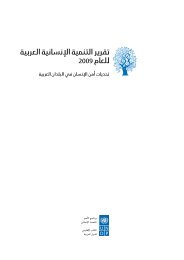arab human development report 2003 - Palestine Remembered
arab human development report 2003 - Palestine Remembered
arab human development report 2003 - Palestine Remembered
- No tags were found...
You also want an ePaper? Increase the reach of your titles
YUMPU automatically turns print PDFs into web optimized ePapers that Google loves.
7.1 Patriarchal Society in Arab Countries7.2 Al Kawakibi: The Inversion of Values Under Despotism8.1 Jamal ad-Din al-Afghani: The Nation and the Authority of a Tyrant8.2 Knowledge and Governance in the Arab World8.3 Imam Muhammad Abduh: Justice and Science8.4 Integrating intellectual property rights and <strong>development</strong> policy8.5 The effects of globalisation on growth and distribution throughout the world – UNCTAD8.6 Trade and Development: Prebisch’s demands still stand9.1 Mustafa Al-Barghouthi – The Road to the Future9.2 Judge Al-Djorjani: The Dues of Science9.3 Lebanon: A Bright Future for Information and Communication Technology?9.4 Imams (religious leaders) advocate ijtihad (scholarship)9.5 Al Kawakibi, on the need for religious reform9.6 Teaching medicine in Arabic is possible!9.7 Paul Alvarus : Mother Tongues9.8 Ibn Rushd (Averroes): The Need to Learn from the Efforts of Previous Nations9.9 Al-Kindi: Appreciating the truth regardless of the source9.10 Ibn Miskawieh: On lauding cultural cross-fertilisation141142148149152158159160164166171173173174175176177177List of Figures1 Democracy is the best form of government2 Rejection of authoritarian rule3 Gender equality in higher education4 Gender equality in employment5 Freedom scores, weighted by population size: the Arab region and other world regions, 1990-2000 (average values)6 Voice and accountability: the Arab region and other world regions7 Perceptions of corruption, Transparency International: position of Arab countries in the sample, 1998 and 20001.1 Bridging the knowledge gap through exponential growth in knowledge acquisition1.2 The knowledge system: a schematic representation1.3 Correlation between Internet penetration and Internet costs -- Arab countries and comparators1.4 PC availability and Internet costs and penetration: Arab countries, OECD and East Asia, 20012.1 Distribution of universities participating in the evaluation according to the overall quality indicator2.2 Detailed evaluation criteria: average values2.3 Number of daily newspapers per 1000 people in Arab countries and other regions in the world, 19982.4 Number of radio receivers per 1000 people in Arab countries and other regions in the world, 20002.5 Number of television sets per 1000 people in Arab countries and other regions of the world, 20002.6 Number of main phone lines per 1,000 persons2.7 Personal computers: Arab world and other regions2.8 Internet penetration in Arab countries, users as % of population, 20012.9 Number of books translated in Arab countries (per 1 million people) compared to selected countries, 1981-19853.1 Ratio of students enrolled in scientific disciplines in higher education in selected Arab countries and Korea 1990-19953.2 Number of scientists and engineers working in research and <strong>development</strong> (per one million people)3.3 Number of publications – original writing and translation – per million people in the Arab world and other regions, 19913.4 Relative distribution of published books by field, ten Arab countries and the world, 19963.5 Number of cinema seats per 1000 persons in selected Arab countries and Korea in the second half of the 1990s4.1 Assessment of key features of knowledge acquisition in Arab countries by gender of respondent (%)4.2 Assessment of the knowledge acquisition process in Arab countries by academic level of respondent (%)4.3 Freedom to pursue knowledge and incentives for knowledge acquisition4.4 Mean years of schooling (MYS), population 15 years of age or older, Arab countries compared to selectedcountries, 1990 and 20004.5 Mean years of schooling (population 25 years of age or older) by gender, Arab countries and three Asian Tigers, 1960-20004.6 Quality adjusted mean years of schooling (QAMYS), population 15 years of age or older, Arab countriesand selected countries, 1990 and 20004.7 Ranking of Arab countries compared to other countries and regions on the composite indicator of knowledge capital, 20004.8 Correlation coefficient between knowledge capital indicators, knowledge outcomes and other <strong>development</strong> indicators5.1 Actors and linkages in the innovation system5.2 The Environment for Investment: 14 Arab countries rated, 19995.3 Distribution of Euro-Arab cooperation projects in research and <strong>development</strong> among Arab countries5.4 Distribution of Euro-Arab cooperation projects among R&D fields7.1 Share of extractive industries in commodity production7.2 Export structure, selected regions.7.3 Annual growth rate of gross domestic product (GDP) per capita (%) Middle East and NorthAfrica and other selected regions, 1970-200019191919282929404146475858595960636464687272787880888889909192939498103108109135135137XV







